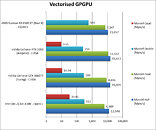- Joined
- Oct 9, 2007
- Messages
- 47,164 (7.57/day)
- Location
- Hyderabad, India
| System Name | RBMK-1000 |
|---|---|
| Processor | AMD Ryzen 7 5700G |
| Motherboard | ASUS ROG Strix B450-E Gaming |
| Cooling | DeepCool Gammax L240 V2 |
| Memory | 2x 8GB G.Skill Sniper X |
| Video Card(s) | Palit GeForce RTX 2080 SUPER GameRock |
| Storage | Western Digital Black NVMe 512GB |
| Display(s) | BenQ 1440p 60 Hz 27-inch |
| Case | Corsair Carbide 100R |
| Audio Device(s) | ASUS SupremeFX S1220A |
| Power Supply | Cooler Master MWE Gold 650W |
| Mouse | ASUS ROG Strix Impact |
| Keyboard | Gamdias Hermes E2 |
| Software | Windows 11 Pro |
SiSoftware put out the mother lode of information on Intel's upcoming Arc "Alchemist" gaming graphics card series, along with OpenCL compute performance of the entry-level Arc A380. The Arc series model numbering is "A" (Alchemist) followed by a number series. The A300 series makes up the entry-mainstream; the A500 series makes up the mid-performance segment; and the A700 series leads the pack with high-end SKUs. The "Alchemist" GPUs are built on the 7 nm silicon fabrication node at TSMC, the N7.
The A300 series is based on the smaller "Alchemist" series dies, with 128 EUs (execution units), which work out to 1,024 programmable shaders. The A500 series and A700 series appear to be carved out from the larger silicon. The A500 series has roughly 384 EU or 3,072 shaders. The top-dog A700 series has all 512 EU or 4,096 shaders enabled. Intel is tapping into industry-standard GDDR6 for dedicated graphics memory. The A300-series SKUs typically have 6 GB of 14 Gbps-rated memory across a 96-bit wide memory bus, for 192 GB/s of bandwidth. The A500 series parts have 12 GB of 16 Gbps-rated memory across a 192-bit bus, for 384 GB/s of bandwidth. The top A700 series maxes out the 256-bit memory bus with 16 GB of memory at 16 Gbps data-rate, for 512 GB/s bandwidth.


Several other interesting features were revealed. Firstly, "Alchemist" supports real-time ray tracing, and meets the full DirectX 12 Ultimate specification. At this point it's not known just how much fixed-function hardware is used to achieve this. The GPU has XMX (hardware for matrix-multiplication). A note on the SIMD components: Xe HPG, or "Alchemist," lacks double-precision floating-point (FP64) acceleration. It only supports FP16 and FP32 (which is all you need for gaming and consumer apps).
SiSoftware tested an entry-level Arc A380 graphics card (1,024 shaders) through its SANDRA GPGPU benchmark that uses native OpenCL code. Here, the A380 was found to be offering performance comparable to a GeForce GTX 1660 Ti "Turing," and hot on the heels of the RTX 3050 "Ampere" and RX 6500 XT RDNA2, in the Mandelbrot half-precision and floating-point tests.
Intel is looking to debut the Arc Alchemist series within the first half of 2022.
View at TechPowerUp Main Site | Source
The A300 series is based on the smaller "Alchemist" series dies, with 128 EUs (execution units), which work out to 1,024 programmable shaders. The A500 series and A700 series appear to be carved out from the larger silicon. The A500 series has roughly 384 EU or 3,072 shaders. The top-dog A700 series has all 512 EU or 4,096 shaders enabled. Intel is tapping into industry-standard GDDR6 for dedicated graphics memory. The A300-series SKUs typically have 6 GB of 14 Gbps-rated memory across a 96-bit wide memory bus, for 192 GB/s of bandwidth. The A500 series parts have 12 GB of 16 Gbps-rated memory across a 192-bit bus, for 384 GB/s of bandwidth. The top A700 series maxes out the 256-bit memory bus with 16 GB of memory at 16 Gbps data-rate, for 512 GB/s bandwidth.


Several other interesting features were revealed. Firstly, "Alchemist" supports real-time ray tracing, and meets the full DirectX 12 Ultimate specification. At this point it's not known just how much fixed-function hardware is used to achieve this. The GPU has XMX (hardware for matrix-multiplication). A note on the SIMD components: Xe HPG, or "Alchemist," lacks double-precision floating-point (FP64) acceleration. It only supports FP16 and FP32 (which is all you need for gaming and consumer apps).
SiSoftware tested an entry-level Arc A380 graphics card (1,024 shaders) through its SANDRA GPGPU benchmark that uses native OpenCL code. Here, the A380 was found to be offering performance comparable to a GeForce GTX 1660 Ti "Turing," and hot on the heels of the RTX 3050 "Ampere" and RX 6500 XT RDNA2, in the Mandelbrot half-precision and floating-point tests.
Intel is looking to debut the Arc Alchemist series within the first half of 2022.
View at TechPowerUp Main Site | Source





